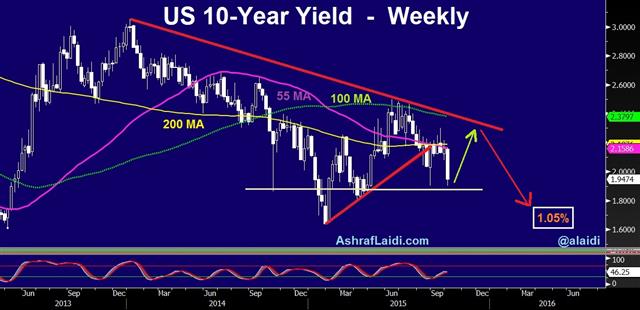Brainard Deals a Blow to Fed Consensus
The growing inverse correlation between the frequency of Fed speeches and uniformity of the message on monetary policy action cannot be ignored. The newest member of the Federal Reserve Board of Governors hasn't made too many speeches, but her message has been on point since her first speech in June.
In her speech yesterday, Lael Brainard, Federal Reserve Governor since June of this year, dealt a prominent blow to the hawks at the Fed, by contradicting three major premises upon which calls for a 2015 rate hike are built. Having served as Undersecretary of the Treasury for International Affairs for over three years, she knows a few things about international developments. Here are some of the central points of her speech:
Market & FX tightening is equivalent to two rate hikes
"Over the past year, a feedback loop has transmitted market expectations of policy divergence between the United States and our major trade partners into financial tightening in the U.S. through exchange rate and financial market channels. Thus, even as lift-off is coming into clearer view ahead, by some estimates, the substantial financial tightening that has already taken place has been comparable in its effect to the equivalent of a couple of rate increases."This is not a foreign idea. Former Treasury Secretary Lawrence Summers made the same point last month about the recent back-up in bond yields and decline in equities. Not to mention the rise in high yield bond spreads hitting three-year highs and long-standing effects of the strong US dollar, we mentioned here.
Economic risks titled to downside
"There is a risk that the intensification of international cross currents could weigh more heavily on U.S. demand directly, or that the anticipation of a sharper divergence in U.S. policy could impose restraint through additional tightening of financial conditions. For these reasons, I view the risks to the economic outlook as tilted to the downside. The downside risks make a strong case for continuing to carefully nurture the U.S. recovery--and argue against prematurely taking away the support that has been so critical to its vitality."Brainard's “tilted to the downside” qualifier contrasts with the Fed central view, which “continues to see the risks to the outlook for economic activity and the labor market as nearly balanced”. Brainard's international focus and experience has led her to integrate the international factors into her assessment for the US, instead of keeping it apart.
Jobs data not enough to judge inflation
"In contrast to the considerable progress in the labor market, progress on the second leg of our dual mandate has been elusive. To be clear, I do not view the improvement in the labor market as a sufficient statistic for judging the outlook for inflation. A variety of econometric estimates would suggest that the classic Phillips curve influence of resource utilization on inflation is, at best, very weak at the moment. The fact that wages have not accelerated is significant, but more so as an indicator that labor market slack is still present and that workers' bargaining power likely remains weak."The statement that tightening labour markets remain insufficient to normalize inflationary considerations has already been made by Fed Chair Yellen and Vice Chairman Fischer recently. But their insistence on communicating a rate hike this year is not shared by Brainard, who advises for “watching and waiting”.
The growing inverse correlation between the frequency of Fed speeches and uniformity of the message is simply a reflection of heightened uncertainty with their economic models. Our expectations that the Fed will not raise rates in 2015 were established since January , confirmed in April and reconfirmed in July, while our calls for the peak in the USD began here. Beware of the extended focus on international affairs at the expense of overlooking a US slowdown, which risks turning into something more. Just as we repetitively warned of the dangers of falling capex, exceeding the advantages of cheaper oil, we warn about the possibility of an “earnings recession” likely to emerge in Q2. A full blown US economic recession is more probable in Q3 2016.

| Act | Exp | Prev | GMT |
|---|---|---|---|
| Fed's Bullard speech | |||
| Oct 13 12:00 | |||
Latest IMTs
-
NFP & CPI Credibility
by Ashraf Laidi | Aug 11, 2025 16:35
-
Forecaster App التطبيق الذي كنت تنتظره
by Ashraf Laidi | Jun 18, 2025 10:55
-
Updating GoldBugs تحديث مناجم الذهب
by Ashraf Laidi | Jun 16, 2025 13:58
-
Breaking Debt Ceiling & Forex Brokers
by Ashraf Laidi | Jun 6, 2025 17:33
-
Recession Metric & Tariff Marsh
by Ashraf Laidi | May 26, 2025 13:47







